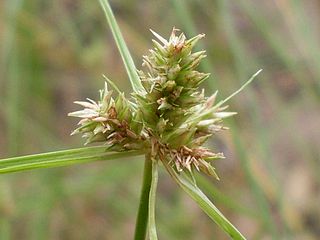
The Cyperaceae are a family of graminoid (grass-like), monocotyledonous flowering plants known as sedges. The family is large, with some 5,500 known species described in about 90 genera, the largest being the "true sedges" genus Carex with over 2,000 species.

Cyperus is a large genus of about 700 species of sedges, distributed throughout all continents in both tropical and temperate regions.

Cyperus bulbosus is a species of sedge found across Africa, the Middle East, Indian subcontinent, Southeast Asia, and Australia. In Australia, it is commonly called Nalgoo or (Australian) bush onion or "wild onion", but is not related to the onion or other Alliaceae. It is a component of Australian bushfood, but is considered an agricultural weed in other areas.

Cyperus squarrosus is a species of sedge known by several common names, including bearded flatsedge and awned flatsedge. It is found in wet environments in North and South America, Africa, Australia, southern Asia and Italy.

Cyperus scariosus is a perennial herbaceous plant from Australia and New Guinea.

Cyperus longus is a species of sedge known by the common names of sweet cyperus and water rush in Africa, or galingale in Britain. It is a tall plant, growing up to a metre in height, with creeping rhizomes and erect, triangular stems, each terminating in an inflorescence. The species grows in shallow water or on damp ground, such as at pond edges.

Cyperus flavescens, commonly known as the yellow flatsedge, is a species of flowering plant belonging to the family Cyperaceae.
Cyperus afrodunensis is a species of sedge that is native to an area in southern Somalia and coastal parts of Kenya.
Cyperus amabilis, commonly known as the foothill flatsedge, is a species of sedge that is native to tropical and sub-tropical areas in the Americas, Africa and Asia.

Cyperus aggregatus, commonly known as the inflatedscale flatsedge, is a species of sedge that is native to the Americas.
Cyperus amuricus, commonly known as the Asian flatsedge, is a species of sedge that is native to parts of Asia.
Cyperus auriculatus, commonly known as the eared flatsedge, is a species of sedge that is native to some islands of Hawaii.

Cyperus capitatus is a species of sedge that is native to northern parts of Africa and southern parts of Europe.
Cyperus cephalanthus, commonly known as the buttonbush flatsedge, is a species of sedge that is native to southern parts of North America and South America.
Cyperus dentatus is a species of sedge that is native to parts of North America.
Cyperus denudatus, commonly known as the winged sedge, is a species of sedge that is native to parts of Africa, Asia and eastern parts of Australia.
Leucopogon confertus, commonly known as Torrington beard-heath, is a species of flowering plant in the heath family Ericaceae and is endemic to a restricted part of New South Wales. It is a small shrub with erect, oblong or lance-shaped leaves, and white, tube-shaped flowers, the petals with shaggy hairs.
Cyperus swartzii, commonly known as Swartz's flatsedge, is a species of sedge that is native to southern parts of North America, northern parts of South America, Central America, and the Caribbean.
Cyperus tatandaensis is a species of sedge that is native to parts of Africa, South America and Central America.








